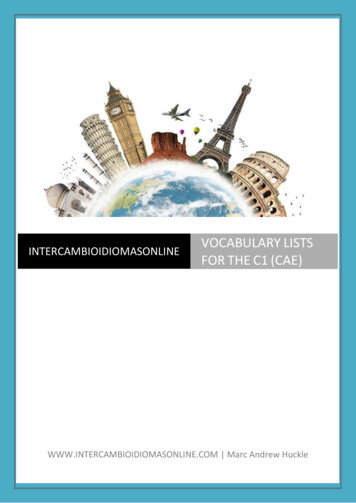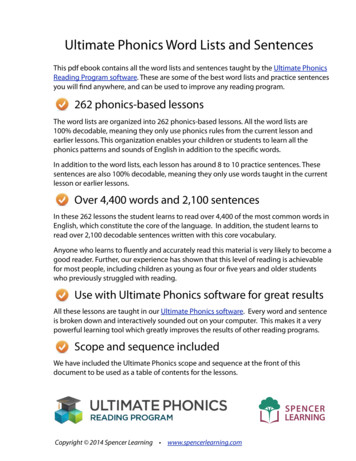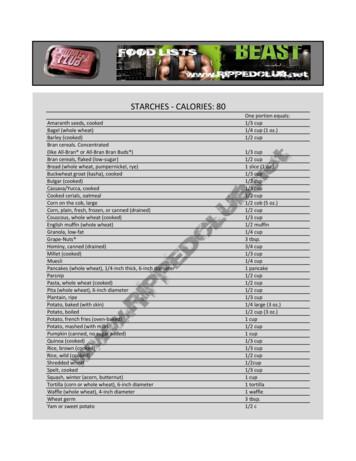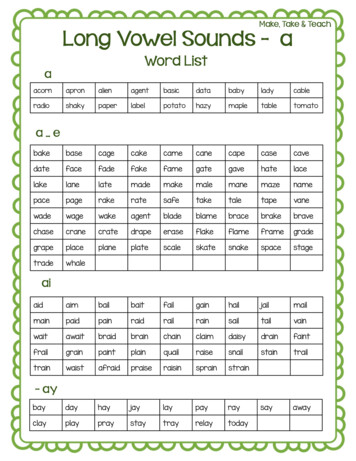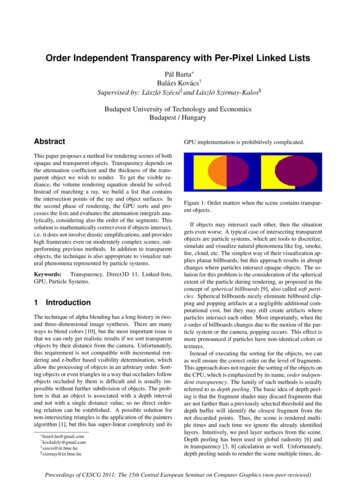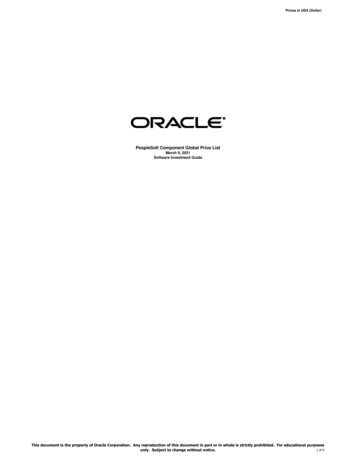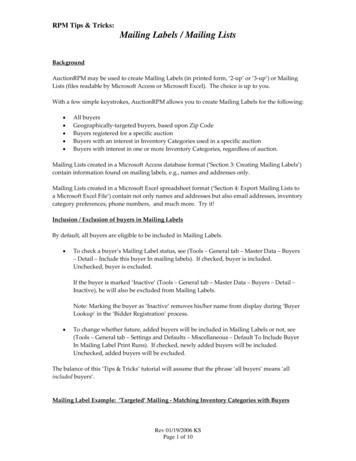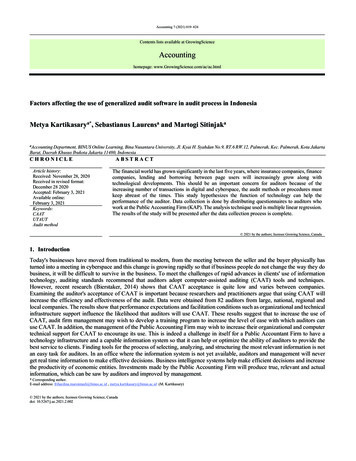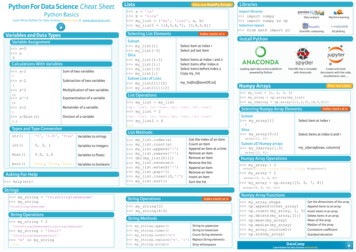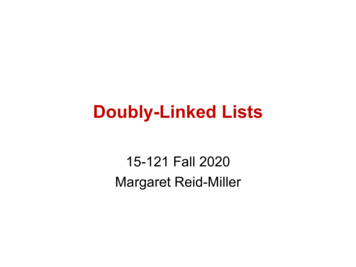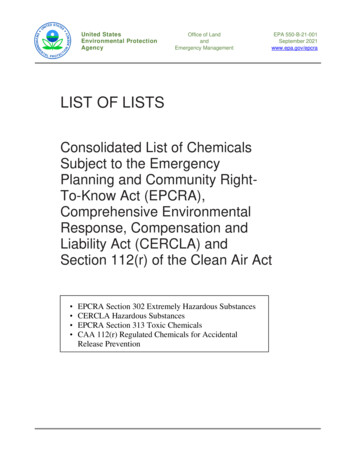
Transcription
United StatesEnvironmental ProtectionAgencyOffice of LandandEmergency ManagementEPA 550-B-21-001September 2021www.epa.gov/epcraLIST OF LISTSConsolidated List of ChemicalsSubject to the EmergencyPlanning and Community RightTo-Know Act (EPCRA),Comprehensive EnvironmentalResponse, Compensation andLiability Act (CERCLA) andSection 112(r) of the Clean Air Act EPCRA Section 302 Extremely Hazardous SubstancesCERCLA Hazardous SubstancesEPCRA Section 313 Toxic ChemicalsCAA 112(r) Regulated Chemicals for AccidentalRelease Prevention
TABLE OF CONTENTSIntroduction . 1List of Lists: Consolidated List of Chemicals (By CAS Number) . 1Appendix A: Consolidated List of Chemicals (By Alphabetical Name) . A-1Appendix B: Radionuclides Listed Under CERCLA . B-1Appendix C: RCRA Waste Streams and Unlisted Hazardous Wastes . C-1Appendix D: EPCRA Section 313, Toxic Release Inventory (TRI) Chemical Categories . D-1Appendix E: .E-1EPCRA Section 313 (TRI) PER- and Polyfluoroalkyl Substances CAS Number Listing . E-1EPCRA Section 313 (TRI) PER- and Polyfluoroalkyl Substances Alphabetical Listing . E-8Appendix F: CERCLA Hazardous Substances - Chemical Categories . F-1ii
TopINTRODUCTIONLIST OF LISTSConsolidated List of Chemicals Subject to the Emergency Planning and Community Rightto-Know Act (EPCRA), Comprehensive Environmental Response, Compensation andLiability Act (CERCLA) and Section 112(r) of the Clean Air ActThis consolidated chemical list includes chemicals subject to reporting requirements under theEmergency Planning and Community Right-to-Know Act (EPCRA), also known as Title III ofthe Superfund Amendments and Reauthorization Act of 1986 (SARA), the ComprehensiveEnvironmental Response, Compensation and Liability Act (CERCLA) and section 112(r) of theClean Air Act (CAA). This consolidated list does not include all hazardous chemicals subject tothe reporting requirements in EPCRA sections 311 and 312, for which material safety data sheets(MSDS) must be developed under the Hazard Communication Standard (29 CFR1910.1200).These hazardous chemicals are identified by broad criteria, rather than by enumeration. There areover 500,000 products that satisfy the criteria. See 40 CFR Part 370 for more information.This consolidated list has been prepared to help facilities handling chemicals determine whetherthey need to submit reports under sections 302 and 313 of EPCRA and determine if releases ofchemicals are reportable under section 102 and 103 of CERCLA and section 304 of EPCRA. Itwill also help facilities determine whether they will be subject to accident prevention regulationsunder CAA section 112(r). This document also includes waste stream codes for listed andunlisted hazardous wastes under the Resource Conservation and Recovery Act (RCRA); a list ofradionuclides reportable under CERCLA and the definitions or explanation of chemicalcategories listed under EPCRA section 313 and CERCLA.Note: This document should be used only as a reference tool, not as a definitive source ofcompliance information. Reporting requirements for EPCRA are published in the Code ofFederal Regulations (CFR), 40 CFR parts 355, 370, and 372. The list of EHS chemicals can befound at 40 CFR 355 Appendix A (alphabetical order) and Appendix B (CAS number order). Thelist of TRI chemicals can be found at 40 CFR 372.65. Reporting requirements for releases ofCERCLA chemicals are in 40 CFR part 302, with list of CERCLA hazardous substances in 40CFR 302.4. Regulatory requirements for accident prevention CAA section 112(r) are publishedin 40 CFR part 68 with the list of Risk Management Program chemicals in 40 CFR 68.130. Theelectronic CFR can be accessed at https://www.ecfr.gov/cgi-bin/ECFR?page browseThe chemicals on the consolidated list are ordered both by the Chemical Abstracts Service(CAS) registry number and alphabetically. Categories of chemicals which generally do not haveCAS registry numbers, but which are cited under CERCLA, have “Not Applicable (N.A.)” listedin place of the CAS number. If the category of chemical is on EPCRA section 313 list, then thesection 313 category code is also included in the CAS number column.This document lists chemicals referenced under five federal statutory provisions, discussedbelow. More than one chemical name may be listed for one CAS number because the samechemical may appear on different lists under different names. For example, for CAS number8001-35-2, the names toxaphene (from the section 313 list), camphechlor (from the section 302list), and camphene, octachloro-(from the CERCLA list) all appear on this consolidated list. Thechemical names on the consolidated lists generally are those names used in the regulatory1
programs developed under EPCRA, CERCLA, and CAA section 112(r), but each chemical mayhave other synonyms that do not appear on these lists.(1) EPCRA Section 302 Extremely Hazardous Substances (EHSs)The presence of Extremely Hazardous Substances (EHSs) in quantities at or above the ThresholdPlanning Quantity (TPQ) requires certain emergency planning activities to be conducted. TheEHSs and their TPQs are listed in 40 CFR part 355, Appendices A and B. For section 302 EHSs,Local Emergency Planning Committees (LEPCs) must develop emergency response plans andfacility owner or operator must notify the State Emergency Response Commission (SERC) orTribal Emergency Response Commission (TERC) and their LEPC if any of the EHS is present atthe facility or above its TPQ. Additionally, if the TPQ is equaled or exceeded, facilities with alisted EHS are subject to the reporting requirements of EPCRA section 311 (provide materialsafety data sheet or a list of covered chemicals to the SERC or TERC, LEPC, and local firedepartment) and section 312 (submit inventory form -Tier I or Tier II). The minimum thresholdfor section 311-312 reporting for EHSs is 500 pounds or the TPQ, whichever is less.TPQ. The consolidated list presents the TPQ (in pounds) for section 302 chemicals in thecolumn following the CAS number. For chemicals that are solids, there are two TPQs given(e.g., 500/10,000). In these cases, the lower quantity applies for solids in powder form withparticle size less than 100 microns, or if the substance is in solution or in molten form.Otherwise, the 10,000 pound TPQ applies. If a solid EHS is in molten form, the facility mustmultiply the amount of EHS on-site by 0.3 before comparing to the lower listed TPQ. If a solidEHS is in solution form, the facility must multiply amount EHS on-site by 0.2 before comparingto the lower listed TPQ. The reducing factors of 0.3 for molten solids and 0.2 for solids insolution are not to be used for the 12 solid reactive chemicals are noted by footnote “a” inAppendix A and B in 40 CFR part 355. These twelve chemicals are not listed with two TPQs andhigher threshold quantity of 10,000 pounds; they only have one TPQ.EHS RQ. Releases of reportable quantities (RQ) of EHSs are subject to state and localreporting under section 304 of EPCRA. EPA has adjusted RQs for EHSs without CERCLARQs to levels equal to their TPQs. The EHS RQ column lists these adjusted RQs for EHSs notlisted under CERCLA and the CERCLA RQs for those EHSs that are CERCLA hazardoussubstances (see the next section for a discussion of CERCLA RQs).Note: Ammonia is listed as an EPCRA EHS with an RQ of 100 pounds in 40 CFR part 355Appendices A and B and covers both anhydrous and aqueous forms, unlike under CERCLAwhere aqueous ammonia is listed separately as ammonium hydroxide, with a higher RQ.(2) CERCLA Hazardous SubstancesReleases of CERCLA hazardous substances, in quantities equal to or greater than theirreportable quantity (RQ), are subject to reporting to the National Response Center underCERCLA. Notification requirements for these releases are found in 40 CFR 302. Suchreleases are also subject to state and local reporting under section 304 of EPCRA. CERCLAhazardous substances, and their reportable quantities, are listed in 40 CFR part 302, Table302.4. Radionuclides listed under CERCLA are provided in a separate list in Appendix B ofthis document, with RQs in Curies. Chemical categories under CERCLA (including metalcompound categories), which have “N.A.” listed for the CAS Number in the consolidated2
table, are also listed in Appendix F of this document with further explanation of eachchemical category, where information was available.RQ. The CERCLA RQ column in the consolidated list shows the RQs (in pounds) forchemicals that are CERCLA hazardous substances.Ammonia and ammonium hydroxide. Under 40 CFR 302.4, CERCLA Hazardoussubstances ammonia and ammonium hydroxide are listed separately, with RQs of 100 and1,000 pounds, respectively. Ammonium hydroxide is an aqueous solution of ammonia.Metals. For metals listed under CERCLA (antimony, arsenic, beryllium, cadmium, chromium,copper, lead, nickel, selenium, silver, thallium, and zinc), no reporting of releases of the solidform is required if the mean diameter of the pieces of the solid metal released is greater than100 micrometers (0.004 inches) (Ref: Footnote after Table 302.4 in 40 CFR 302.4). The RQsshown on the consolidated list apply to smaller particles.Note that the consolidated list does not include all CERCLA regulatory synonyms. See 40CFR part 302, Table 302.4 for a complete list.Sulfur monochloride. (formula S2Cl2) is listed with an incorrect CAS number of 12771-08-3,which is found on the CERCLA Hazardous Substances list. The correct CAS number shouldbe 10025-67-9, however, the List of Lists will still include the CAS number of 12771-08-3because it has not been changed on the CERCLA list. According to the Chemical AbstractServices which assigns CAS numbers, the correct CAS number for sulfur monochloride is10025-67-9, which is now included on the List of Lists with an explanatory footnote.CAS number 12771-08-3 is assigned to the substance sulfur chloride (formula SCl-) which waslisted as a synonym for sulfur monochloride when EPA finalized the Clean Water ActDesignation of Hazardous Substances rule (43 FR 10474, March 13, 1978). The CAS number10025-67-9 is used for sulfur monochloride on EPA’s TSCA Inventory and EPA’s SubstanceRegistry Services lists. Seehttps://ofmpub.epa.gov/sor internet/registry/substreg/LandingPage.do(3) CAA Section 112(r) List of Substances for Accidental Release PreventionUnder the accident prevention provisions of section 112(r) of the CAA (also known as RiskManagement Program or RMP), EPA developed a list of 77 toxic substances and 63 flammablesubstances. Threshold quantities (TQs) were established for these substances. The list and TQsidentify processes subject to accident prevention regulations. The list of substances and TQs andthe requirements for risk management programs for accidental release prevention are found in 40CFR part 68. This consolidated list includes both the common name for each listed chemical undersection 112(r) and the chemical name, if different from the common name, as separate listings.The CAA section 112(r) list includes several substances in solution that are covered only inconcentrations above a specified level. These substances include ammonia (concentration 20% orgreater) (CAS number 7664-41-7); hydrochloric acid (37% or greater) (7647-01-0); hydrogenfluoride/hydrofluoric acid (50% or greater) (7664-39-3); and nitric acid (80% or greater) (7697-372). Hydrogen chloride (anhydrous) and ammonia (anhydrous) are listed, in addition to the solutionsof these substances, with different TQs. Only the anhydrous form of sulfur dioxide (7446-09-5) iscovered. These substances are presented on the consolidated list with the concentration limit or3
specified form (e.g., anhydrous), as they are listed under CAA section 112(r). Flammable fuelsused as a fuel or held for sale as a fuel at a retail facility are not subject to the rule.TQ. The CAA section 112(r) TQ column in the consolidated list shows the TQs (in pounds)for chemicals listed for accidental release prevention. The TQ applies to the quantity ofsubstance in a process, not at the facility as a whole.(4) EPCRA Section 313 Toxic Chemicals (a.k.a Toxics Release Inventory (TRI) Chemicals)Emissions, transfers, and waste management data for chemicals listed under section 313 mustbe reported annually as part of the community right-to-know provisions of EPCRA (40 CFRpart 372). These reports are also known as Toxics Release Inventory (TRI) reports.Section 313. The notation “313” in the column for section 313 indicates that the chemical issubject to reporting under section 313 and section 6607 of the Pollution Prevention Act under thename listed. In cases where a chemical is listed under section 313 with a second name inparentheses or brackets, the second name is included on this consolidated list with an “X” in thesection 313 column. An “X” in this column also may indicate that the same chemical with thesame CAS number appears on another list with a different chemical name. The “X” listed withthe chemical name “Ammonia (anhydrous)” and “Ammonia (concentration of 20% or greater)”does not mean that the section 313 reporting for these substances are limited to those forms, butit does include them.Ammonium Salts. The EPCRA section 313 listing for ammonia includes the followingqualifier “includes anhydrous ammonia and aqueous ammonia from water dissociableammonium salts and other sources; 10 percent of total aqueous ammonia is reportable underthis listing.” The qualifier for ammonia means that anhydrous forms of ammonia are 100%reportable and aqueous forms are limited to 10% of total aqueous ammonia. Therefore, whendetermining threshold and releases and other waste management quantities all anhydrousammonia is included but only 10% of total aqueous ammonia is included. Any evaporation ofammonia from aqueous ammonia solutions is considered anhydrous ammonia and should beincluded in threshold determinations and release and other waste management calculations.In this document ammonium salts are not specifically identified as being reportable EPCRAsection 313 chemicals. However, water dissociable ammonia salts, such as ammonium chloride,are reportable if they are placed in water. When ammonium salts are placed in water, reportableaqueous ammonia is manufactured. As indicated in the ammonia qualifier, all aqueousammonia solutions from water dissociable ammonium salts are covered by the ammonia listing.For example, ammonium chloride is a water-dissociable ammonium salt and reportable aqueousammonia will be manufactured when it is placed in water.Unlike other ammonium salts, ammonium hydroxide is specifically identified as being areportable EPCRA section 313 chemical. This is because the chemical ammonium hydroxide(NH4OH) is a misnomer. It is a common name used to describe a solution of ammonia in water(i.e., aqueous ammonia), typically a concentrated solution of 28 to 30 percent ammonia. EPAhas consistently responded to questions regarding the reportability of these purportedammonium hydroxide solutions under the EPCRA section 313 ammonia listing by stating thatthese are 28 to 30 percent solutions of ammonia in water and that the solutions are reportableunder the EPCRA section 313 ammonia listing. For a more detailed discussion, see page 34175of the Federal Register final rule of June 30, 1995 (60 FR 34172) on TRI reporting for4
Ammonia; Ammonium Sulfate (solution); Ammonium Nitrate (solution); Water DissociableAmmonium Salts, (See ts-toxic. (See also EPA’s TRI Guidance for Reporting Aqueous Ammonia, EPA745-B-19-002, revised in February 2019 athttps://ofmpub.epa.gov/apex/guideme ext/f?p guideme:gd-title:::::title:ammonia )Stayed TRI Chemicals. There are two EPRCA section 313 chemicals that are listed in the CFRbut for which the Agency has issued an administrative stay that excludes them from reportinguntil the stays are lifted. These chemicals, identified by “313s” in the Sec. 313 table column, aremethyl mercaptan (CAS number 74-93-1), and 2, 2-dibromo-3-nitrilopropionamide (CASnumber 10222-01-2). Check the TRI website ogram/tri-listed-chemicals for updated regulatory information.New TRI Chemicals. Section 7321 of the National Defense Authorization Act for Fiscal Year2020 (P.L. 116-92) (NDAA) added certain Per- and Polyfluoroalkyl Substances (PFAS) to theTRI list. Among these added chemicals are chemicals that met two criteria: (1) they were subjectto a significant new use rule at either 40 CFR 721.9582 or 721.10536 on or before December 20,2019; and (2) they were identified as active in commerce on the Toxic Substances Control Act(TSCA) Inventory that was published in February 2019. Chemicals meeting only one of the twocriteria were not added to the TRI list.The names and CASRNs for some of the chemicals listed under 40 CFR 721.9582 and/or 40CFR 721.10536 are subject to a claim of protection from disclosure. Under Section 7321 of theNDAA, EPA must review any such chemicals before the chemicals are added to the TRI list(NDAA Section 7321(e)). Therefore, the chemicals that are subject to a claim of protection fromdisclosure will not be added to the EPCRA Section 313 toxic chemical list until EPA completesthe process provided by Section 7321(e) of the NDAA.Via the considerations described above, 170 chemicals were identified. Additionally, the NDAAspecifically identified fourteen PFAS for addition to the TRI list. Twelve of these fourteenchemicals were among the chemicals described above; with the addition of the other two, thereare a total of 172 PFAS subject to the NDAA. See Appendix E of this document.Under the automatic listing provisions of the 2020 NDAA, three additional PFAS were added forreporting year 2021. The three new PFAS are: Silver(I) perfluorooctanoate (335-93-3),Perfluorooctyl iodide (507-63-1), and Potassium perfluorooctanoate (2395-00-8). Reportingforms on these chemicals are due July 1, 2022, for 2021 data if TRI reporting thresholds are met.(5) Chemical CategoriesThe CERCLA and EPCRA section 313 lists include a number of chemical categories as well asspecific chemicals. Categories appear on this consolidated list at the beginning of the CASnumber order listing. The specific chemicals or substances that are included in the CERCLAcategory Radionuclides can be found in Appendix B. Appendix D contains explanations anddefinitions for the EPCRA section 313 (TRI) chemical categories. For the CERCLA listedcategories reported with CAS number of N.A., Appendix F contains information available onthe CERCLA chemical categories from their original statutory and regulatory sources.5
Specific chemicals listed as members of the diisocyanates, dioxin and dioxin-like compounds,hexabromocyclododecane, nonylphenol, nonylphenol ethoxylates and PAC categories underEPCRA section 313 are included in the list of specific chemicals by CAS number, not in thecategory listing.EPA has attempted to identify those chemicals on the consolidated list that are clearlyreportable under one or more of the EPCRA section 313 (TRI) chemical categories. Forexample, mercuric acetate (CAS number 1600-27-7), listed under section 302, is notspecifically listed under section 313, but is reportable under the section 313 “MercuryCompounds” category (no CAS number). Listed chemicals that have been identified as beingreportable under one or more EPCRA section 313 categories are identified by “313c” in theSec. 313 table column.The chemicals on the consolidated list have not been systematically evaluated to determinewhether they fall into any of the CERCLA listed categories. Some chemicals not specificallylisted under CERCLA may be subject to CERCLA reporting as part of a category. Forexample, strychnine sulfate (CAS number 60-41-3), listed under EPCRA section 302, is notindividually listed on the CERCLA list, but is subject to CERCLA reporting under the listingfor strychnine and salts (CAS number 57-24-9), with an RQ of 10 pounds. Similarly, nicotinesulfate (CAS number 65-30-5) is subject to CERCLA reporting under the listing for nicotineand salts (CAS number 54-11-5, RQ 100 pounds), and warfarin sodium (CAS number 129-066) is subject to CERCLA reporting under the listing for warfarin and salts, concentration 0.3% (CAS number 81-81-2, RQ 100 pounds).Note that some CERCLA listings, although they include CAS numbers, are for generalcategories and are not restricted to the specific CAS number (e.g., warfarin and salts). TheCERCLA list also includes a number of generic categories that have not been assigned RQs;chemicals falling into these categories are considered CERCLA hazardous substances, butthey are not required to be reported under CERCLA unless otherwise listed under CERCLAwith an RQ.(6) RCRA Hazardous WastesThe consolidated list includes specific chemicals from the RCRA P and U lists only (40 CFR261.33). This listing is provided as an indicator that companies may already have data on aspecific chemical that may be useful for EPCRA reporting. It is not intended to be acomprehensive list of RCRA P and U chemicals. RCRA hazardous wastes consisting of wastestreams on the F and K lists, and wastes exhibiting the characteristics of ignitability, corrosivity,reactivity, and toxicity, are provided in Appendix C in this document. This list also includesK181 hazardous waste with a statutory one-pound RQ (indicated by an asterisk “*” following theRQ. The descriptions of the F and K waste streams have been abbreviated; see 40 CFR part 302,Table 302.4, or 40 CFR part 261 for complete descriptions.RCRA Code. The letter-and-digit code in the RCRA Code column is the chemical's RCRAhazardous waste code.6
Summary of CodesCodes in Section 313 column Member of EPCRA Section 313 PAC category.#Member of EPCRA Section 313 Diisocyanate category.cAlthough not listed by name and CAS number, this chemical is reportable under one ormore of the EPCRA section 313 chemical categories.sIndicates that this chemical is currently under an administrative stay of the EPCRAsection 313 reporting requirements, therefore, no Toxics Release Inventory reports arerequired until the stay is removed.!Member of the EPCRA section 313 Dioxin and dioxin-like compounds category.XIndicates that this is a second name for an EPCRA section 313 chemical already includedon this consolidated list. May also indicate that the same chemical with the same CASnumber appears on another list with a different chemical name. Member of the EPCRA section 313 Nonylphenol category. Member of the EPCRA section 313 Hexabromocyclododecane category.%Member of the EPCRA section 313 Nonylphenol Ethoxylates category.Codes in CERCLA RQ column*The Agency may adjust the statutory RQ for this RCRA hazardous substance (K181waste) in a future rulemaking; until then the statutory one-pound RQ applies. K codeswastes are listed in Appendix C.PMN This EHS chemical was identified from a Premanufacture Review Notice (PMN)submitted to EPA. The submitter has claimed certain information on the submission to beconfidential, including specific chemical identity.&Indicates that no RQ is assigned to this generic or broad class, although the class is aCERCLA hazardous substance. See 50 Federal Register 13456 (April 4, 1985).@Releases in amounts less than 1,000 pounds per 24 hours of nitrogen oxide or nitrogendioxide to the air that are the result of combustion and combustion related activities areexempt from the notification requirements of EPCRA section 304 and CERCLA.§The adjusted RQs for radionuclides may be found in appendix B in this document.7
Codes in Name column1Sulfur monochloride (formula S2Cl2) is listed with an incorrect CAS number of 1277108-3, which is found on the CERCLA Hazardous Substances list. The correct CASnumber should be 10025-67-9 according to the Chemical Abstract Services. However,the List of Lists has sulfur monochloride with both CAS numbers because CASnumber 12771-08-3 has not been changed on the CERCLA list.††No reporting of releases of this CERCLA hazardous substance is required underCERCLA if the diameter of the pieces of the solid metal released is larger than 100micrometers (0.004 inches).†††The RQ for asbestos is limited to friable forms only.aBenzene was already a CERCLA hazardous substance prior to the CAA Amendmentsof 1990 and received an adjusted 10-pound RQ based on potential carcinogenicity in anAugust 14, 1989, final rule (54 FR 33418). The CAA Amendments specify that“benzene (including benzene from gasoline)” is a hazardous air pollutant and, thus, aCERCLA hazardous substance.bThe CAA Amendments of 1990 list DDE (3547-04-4) as a CAA hazardous airpollutant. The CAS number, 3547-04-4, is for the chemical, p, p′ dichlorodiphenylethane. DDE or p, p′- dichlorodiphenyldichloroethylene, CAS number72-55-9, is already listed in Table 302.4 with a final RQ of 1 pound. The substanceidentified by the CAS number 3547-04-4 has been evaluated and listed as DDE to beconsistent with the CAA section 112 listing, as amended.cIncludes mineral fiber emissions from facilities manufacturing or processing glass,rock, or slag fibers (or other mineral derived fibers) of average diameter 1 micrometeror less.dFor CERCLA hazardous substances, includes mono- and di-ethers of ethylene glycol,diethylene glycol, and triethylene glycol R-(OCH2CH2)n-OR′ where:n 1, 2, or 3;R alkyl C7 or less; orR phenyl or alkyl substituted phenyl;R′ H or alkyl C7 or less; orOR′ consisting of carboxylic acid ester, sulfate, phosphate, nitrate, or sulfonate.Note: the phrase “mono- and di-ethers of ethylene glycol, diethylene glycol, andtriethylene glycol” is not included the TRI definition, but the defined formula is thesame for the CERCLA and TRI listing and by formula definition would cover“mono- and di-ethers of ethylene glycol, diethylene glycol, and triethylene glycol.”eIncludes organic compounds with more than one benzene ring, and which have aboiling point greater than or equal to 100 C.Code in RCRA Waste Stream CodesfSee 40 CFR 302.6(b)(1) for application of the mixture rule to this hazardous waste. SeeAppendix C for listing of “K” code RCRA waste streams.8
TopLIST OF LISTS: CONSOLIDATED LIST OF CHEMICALS(BY CAS NUMBER)SUBJECT TO EPCRA, CERCLA AND CAA SECTION 112(r)NAMEChlordane (Technical Mixture andMetabolites)Chlorinated BenzenesChlorinated EthanesChlorinated NaphthaleneChloroalkyl EthersCoke Oven EmissionsCreosoteCyanides (soluble salts andcomplexes), not otherwise specifiedDDT and ulfan and MetabolitesEndrin and MetabolitesFine mineral fibers cHaloethersHalomethanesHeptachlor and MetabolitesNitrophenolsNitrosaminesPhthalate EstersPolycyclic organic matterPolynuclear Aromatic HydrocarbonsRadionuclides (including Radon)Antimony CompoundsArsenic CompoundsBarium CompoundsBeryllium CompoundsCadmium CompoundsChlorinated PhenolsChlorophenolsChromium CompoundsCobalt CompoundsCopper CompoundsCyanide CompoundsDiisocyanates (includes only 20chemicals)Dioxin and dioxin-like compounds(includes only 17 chemicals)Ethylenebisdithiocarbamic acid, saltsand estersGlycol Ethers 100N106N120Section 302(EHS) TPQSection304EHSRQCAASection RCRA112(r)313 CODETQCERCLARQ&&&&&11U05110 313c 3313313313313313N150313N171313N230&313
Lead CompoundsManganese CompoundsMercury CompoundsNickel CompoundsNicotine and saltsNitrate compounds (water dissociable)Nonylphenol (includes only 6chemicals)Nonylphenol EthoxylatesPolybrominated Biphenyls (PBBs)Polychlorinated alkanes (C10 to C13)Polycyclic aromatic compounds e(includes only 23 chemicals)Selenium CompoundsSilver CompoundsStrychnine and saltsThallium CompoundsVanadium CompoundsWarfarin and saltsZinc CompoundsOrganorhodium Complex (PMN-82147)FormaldehydeFormaldehyde (solution)Mitomycin serpinePiperonyl namineMechlorethamineNitrogen mustardCarbamic acid, ethyl esterEthyl carbamateUrethaneCarbachol chloridePhosphonic acid, (2,2,2-trichloro-1hydroxyethyl)-,dimethyl 50N458N495N503N511N530Section 302(EHS) TPQSection304EHSRQCAASection RCRA112(r)313 CODETQCERCLARQ313 00-050050-00-050050-07-7500/10,00050-14-6 350050010&PMN10010010313313313313313313313313XU122 15,000U122 15,000U01010U0581U0611 313 U0225,000U200313313X10 313 38500100 3131,000 313 P0971 313 U0632
NAME2-AcetylaminofluoreneNicotineNicotine and saltsPyridine, 3-(1-methyl-2-pyrrolidinyl)-,(S)- , & rphateMethylthiouracilCarbon tetrachlorideCantharidinBis(
The chemicals on the consolidated list are ordered both by the Chemical Abstracts Service (CAS) registry number and alphabetically. Categories of chemicals which generally do not have CAS registry numbers, but which are cited under CERCLA, have “
